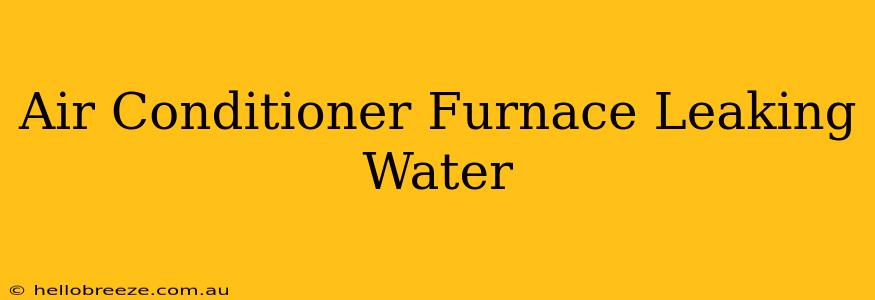Is your air conditioner or furnace leaking water? This is a serious problem that needs immediate attention. Leaking water can damage your home, lead to mold growth, and even cause costly repairs. This guide will help you diagnose the source of the leak and offer solutions to get your system back in working order.
Identifying the Source of the Leak
Before you start troubleshooting, locate the exact source of the water leak. Is it dripping from the air conditioner, the furnace, or somewhere in between? Knowing the location will help narrow down the possible causes.
Common Causes of AC Leaks:
- Clogged condensate drain line: This is the most frequent cause of AC leaks. The condensate drain line removes moisture from the air conditioner. If it becomes clogged with algae, dirt, or other debris, water will back up and overflow.
- Frozen evaporator coil: A frozen evaporator coil restricts airflow and can cause ice to melt and leak. This often results from restricted airflow due to a dirty air filter or clogged air vents.
- Leaking condensate pan: The condensate pan collects moisture. If it cracks or develops a hole, water will leak out.
- Improper installation: Incorrectly installed ductwork or a poorly sloped condensate drain line can cause leaks.
Common Causes of Furnace Leaks:
- Cracked heat exchanger: A cracked heat exchanger is a serious safety hazard and requires immediate professional attention. Never operate a furnace with a cracked heat exchanger.
- Leaking condensate drain pan (for high-efficiency furnaces): High-efficiency furnaces produce condensation, which needs to be drained. A leaking drain pan will result in water leaks.
- Condensation on the ductwork: Excessive humidity in your home can cause condensation to form on the ductwork, leading to leaks.
Troubleshooting Steps
1. Check the Air Filter: A dirty air filter restricts airflow, leading to freezing and leaks in your AC unit. Replace the filter immediately.
2. Inspect the Condensate Drain Line: Carefully examine the condensate drain line for clogs. You might need a shop vac or a drain snake to clear any blockages. Pour a cup of water down the drain line to test if it is flowing freely.
3. Examine the Condensate Pan: Check the condensate pan for cracks or holes. If damaged, it needs to be replaced.
4. Check for Frozen Evaporator Coils: If you suspect a frozen evaporator coil, turn off the AC unit and allow it to thaw completely before attempting to diagnose the cause.
5. Look for Leaks in the Ductwork: Inspect the ductwork for any visible cracks or holes that might be causing condensation and leaks.
When to Call a Professional
If you've tried the troubleshooting steps and the leak persists, or if you suspect a cracked heat exchanger, call a qualified HVAC technician immediately. Attempting repairs yourself on complex systems can worsen the problem and potentially cause further damage. A professional can accurately diagnose the issue and perform necessary repairs safely and efficiently.
Remember: Ignoring a leaking air conditioner or furnace can lead to significant damage, mold growth, and safety hazards. Address the problem promptly to protect your home and your family.
Keywords: Air conditioner leaking water, furnace leaking water, AC leak, furnace leak, condensate drain, clogged drain line, frozen evaporator coil, cracked heat exchanger, HVAC repair, troubleshooting AC leaks, troubleshooting furnace leaks, home maintenance.

